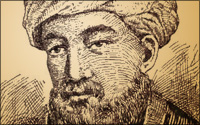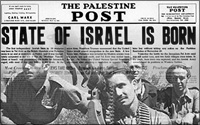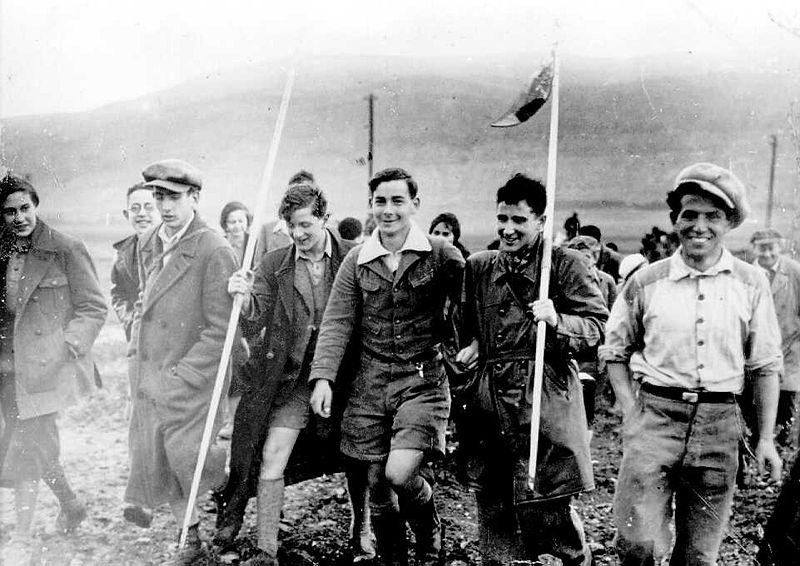 The Golden Age of the Jews in Spain can be symbolized by one person, arguably the greatest person that the people produced from the time of the Talmud until our day: Rabbi Moses ben Maimon, also known as Maimonides or the Rambam.
The Golden Age of the Jews in Spain can be symbolized by one person, arguably the greatest person that the people produced from the time of the Talmud until our day: Rabbi Moses ben Maimon, also known as Maimonides or the Rambam.
The epitaph on his grave reads, “From Moses to Moses, there arose none like Moses.” It is no exaggeration. Maimonides’s influence on the Jewish people approached the influence of Moses himself.
Maimonides’ life marks the zenith of Spanish Jewry. From his time onward it will be downhill… politically, economically, socially and every way possible. In fact, during his life the clouds that gathered over the Jews were already present.
A Brief Biographical Sketch
Maimonides was born in Cordoba in 1135 CE. His father was a judge in the Jewish community and the family tree was traced back to King David himself.
For the first 15 years of life he was raised in his father’s home. To a great extent his father was his main teacher. The other teacher he mentions was the great Rabbi Joseph ibn M’gash, who was the last disciple of Rabbi Isaac Alfasi, the “Rif.”
It is superfluous to say that the Maimonides was blessed with a superior mind and willpower to study. By the time he was 15, he had acquired a complete education. He was, if we can use the term for a person of the twelfth century, a renaissance man. Maimonides was not just a Talmudic scholar, but a philosopher, astronomer, mathematician, physician, linguist, poet and a critic. And he was entirely self-taught.
In 1150 CE, when the Maimonides was only 15, an event occurred that not only had tremendous bearing on his life, but on all of Spanish-Jewish history. The Muslims controlled Spain at that time, and for the first 400 years that the Jews were there they lived in peace and comfort because the Moors, the Muslims who ruled Spain, were moderate; they did not take Islam too literally. But a sect of fundamentalist Muslims called the Almohads, “the devotees of Mohammed,” staged revolutions throughout Spain. They overthrew the moderates and demanded a strict interpretation and enforcement of all the laws in the Quran.
In 1150 CE, they gained control of the Maimonides’ home city of Cordoba. One of their first acts was to force the Jews of Cordoba to convert to Islam or leave behind their homes and businesses; essentially all their wealth. Many Jews were loath to give up their possessions and sought to ride out the storm by converting and remaining in Cordoba.
Maimonides and his family did not stay around. They fled Cordoba. Indeed, they were so frightened that the Almohads would sweep all of Spain that they left the Spanish peninsula entirely, crossed the Mediterranean and settled in Morocco. However, when they arrived in Fez an Almohad revolution broke out there, too, so they escaped to the Atlas Mountains where they lived in a cave for seven to nine years.
Maimonides never recovered from the traumatic arrival of the Almohads. A portion of this is reflected in the personal animosity Maimonides harbored toward Islam and the Quran. To a certain extent, he blamed the death of his parents and other personal tragedies — including the death of his first wife and children (both died in a plague) and beloved brother (a merchant who apparently sustained the family) — on the fact that his family had been exiled and uprooted, and that they always had the terror of the Almohads hanging over their heads.
Commentary on the Mishnah
Incredibly, during the time that they lived in the cave Maimonides wrote the first of his three great works, his commentary on the Mishnah, which was eventually published when he settled in Cairo at age 24. Any one of the Maimonides’ works by itself would be enough to guarantee him immortality, but the three together raised him to the gargantuan stature that he occupies today.
The book, like all of the Maimonides’s works, was innovative to the point of being revolutionary. First, he wrote it in Arabic (yet in Hebrew script). Second, he summed up the basic theology of the Jewish people in sweeping introductions, including was became known as the “13 Principles of Faith.” This may not sound like an innovation, but theology is not central to Judaism in the way it is in Christianity and Islam. The great nineteenth century Jewish leader, Rabbi Samson Rafael Hirsch, summed it up this way, “Christianity is a religion invented by humanity to describe God, while Judaism is a religion created by God to describe humanity.” Judaism is more concerned with dealing with human beings and how they are expected to behave. If you scour the entire Talmud, you will find relatively little of what can be termed “theology.” However, Maimonides felt that the Jews of the time needed a philosophical basis for understanding the Jewish faith and did so through his introductions to his commentary on the Mishnah.
As often happens in history, whenever someone comes up with something new there is a strong reaction. Often, the more innovative and positive the new thing is the stronger the reaction. So while Maimonides reigns supreme in our time, during his lifetime and a century after his death he was considered so controversial that his books were banned and even burned by some. He likewise had supporters who defended him with tremendous ferocity. But the ultimate testament is that after 800 years, his works remain indispensible in the study and practice of Jewish law.
A Day in the Life…
Maimonides eventually came to what is today Cairo, called Fustat back then, to escape from the Almohads. He would live in Egypt for the balance of his life, the next 45 years.
The first problem was that it says three times in the Torah that Jews are not supposed to go back to live in Egypt. Even as Maimonides felt compelled to move there to escape the Almohad terror, he did not have an easy conscience regarding it. We have a number of his letters he wrote to Jews in France, Spain, Iraq and Syria. In each he signed the letter, “Rabbi Moses ben Maimon, from Spain, who every day transgresses three commandments in the Torah [not to live in Egypt].”
It was apparently his aim to settle in the Holy Land, but this was the time of the Third Crusade. The king in Egypt was the famous Saladin[1] who defeated Richard the Lion-Hearted and ended the Christian Crusader kingdom in Palestine. The land was in ruins, including the Jewish community. Therefore, Maimonides had to settle permanently in Cairo.
When he arrived he began to practice medicine. We have extant today a number of his medical writings, including those on dermatology, pharmacology and anatomy. His reputation eventually reached the halls of the king, who made him the house physician for his harem. It goes without saying that Maimonides was a very busy doctor.
In several of his letters he describes the pressures of this work. If the king did not like you it was off with your head. Even without that, a typical day was excruciatingly demanding. He writes, for instance, how in a typical day he got up before dawn, then worked at his studies and books, then went to pray, then went to court and spent the day until the middle of the afternoon tending medical needs, then people from all over the world would come to talk to him to ask questions and then, finally at the end of the day, he was so tired that his servant had to lift him upon the donkey, which went home by itself.
When we read about his day his literary accomplishments are even more mind-boggling. Where did he even have the time to write all this, to say nothing of thinking about it in such an organized, integrated way?
Mishnah Torah
During his middle years, he completed his magnum opus, the Mishnah Torah (the “Review of the Torah”). It is the encyclopedia of Jewish law and tradition. Like his commentary on the Mishnah, it was a revolutionary book.
On the merit of organization alone it is a masterpiece. It was divided into 14 volumes. Each volume was divided into sections and sub-sections, each sub-section having numbered paragraphs and even sub-paragraphs. Indeed, its system of organization is so perfect that later generations were able to deduce nuances of his meaning simply by seeing where he placed the law.
Likewise, even his use of language was masterful and revolutionary. He wrote it in a clear, concise, classic style of Hebrew that has no equal.
Maimonides had said about his Mishnah Torah, “He who has my book will need no other book of Jewish scholarship.” In God’s irony, however, there is no book in human history that has spawned as many other books upon it. There are more than 10,000 known volumes of commentary upon this work!
The Mishnah Torah was not without its controversies. Nevertheless, it was widely accepted by Jewish communities throughout the world. It has more than survived the test of time. It is the magnum opus of Jewish scholarship. There is no book that approaches it. No person who considers himself a Jewish scholar can exist without intimate familiarity with its contents.
Guide for the Perplexed
The third great book by Maimonides is his most controversial, the Moreh Nebuchim, usually translated as “Guide for the Perplexed” or “The Guide of the Perplexed.” A disciple named Joseph ben Judah[2] wrote to Maimonides as follows: “My Master, My Teacher, in an intelligent world, in world based on Aristotelian philosophy, in a world of overwhelming Christianity and Islam, how can we explain to Jews who have lost their way that Judaism is correct?”
Assimilation is not a new phenomenon. In every generation there were Jews who converted, left and deserted. In our time, the opportunity is stronger, but in the time of Maimonides too there were segments of the Jewish people who did not believe or did not know what to believe or who wanted a rational underpinning for their faith.
Joseph ben Judah basically asked his master for the rational explanation of Judaism for people who were searching for a rational explanation. In the medieval world Aristotle was infallible. The world thought in his terms. They used his systems of astronomy and physics. And the “Guide for the Perplexed” came to explain Judaism to those immersed in this outlook. Indeed, the book was written in Arabic, which itself is the first clue of its target audience.
The “Guide for Perplexed” not only gained wide popularity but wide controversy. While Maimonides was alive his critics were prevalent but not overly zealous. After his death, however, they turned zealous, even vicious. The “Guide for Perplexed” was even burned publicly by Jews and non-Jews. There were Jews in France who informed against the book to the Catholic Church, saying that it made slights against Christianity. Therefore, the Church burned the book.
Those Jews, sadly, did not realize that the Church was not going to be sophisticated enough to make distinctions. Once they learned that one book could be burned they burned other books as well, including the Talmud. Every copy of the Talmud in France was burned by Louis IX, for which he was canonized and became St. Louis.
The controversy regarding “The Guide for Perplexed” remained until our time. Indeed, even today there are certain segments of the Jewish population that have a resistance to reading or even possessing it.
Maimonides died shortly before turning 70. When he was already getting weak he said that if he had to do it over he would not have written it in Arabic, but in Hebrew to express some of his thoughts more clearly. But time caught up to him. He had no time to write it again or even rethink whether it should have been written.
Legends about his Death
Maimonides died in Cairo in 1204. There are great legends regarding his death and burial. Today we honor his burial place in the city of Tiberius. As the legend goes, he wanted to be buried there because according to Jewish tradition it was the last place that the Great Sanhedrin had met before persecution forced it to disband and with the advent of the Messianic Era the Great Sanhedrin will be reconstituted and meet again in Tiberius. Since he was the bulwark of Jewish law he wanted to be there.
Another legend has it that as he was taken to burial in the land of Israel, not necessarily Tiberius, his funeral cortege was attacked by Arabs and the animal carrying his body ran away to Tiberius, where it was found by Jews who buried him there.
A third legend was that as the funeral cortege was on its way to Israel it was surrounded by Arabs who wanted a ransom, but then they saw a vision that this was the body of a holy man and it so frightened them that they changed from being robbers to becoming the caravan’s protectors and accompanied it to its burial place in Tiberius.
The common thread in each of the legends ascribes a superhuman quality to Maimonides. Superhuman or not, so great was his influence, so strong his personality and so accepted were his works among the Jewish people that his epitaph tells it all, “From Moses to Moses, there arose none like Moses.”
[1] Maimonides would have influence on Saladin. In fact, Saladin so respected him that he appointed him as the president, the “Nagid,” of the Jewish community in Egypt, an official post in the government. As a result, Maimonides was able to obtain from Saladin many political favors for the Jews in the Holy Land as well as the Muslim world generally. Through his influence he was able to modify the hold of the fundamentalists, which would have forced terrible times upon the Jews.
[2] Some say it was Joseph ben Judah ibn Aknin. Others say it was Joseph ben Judah of Ceuto.












